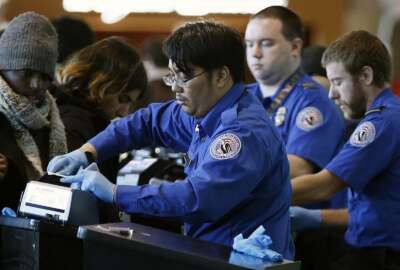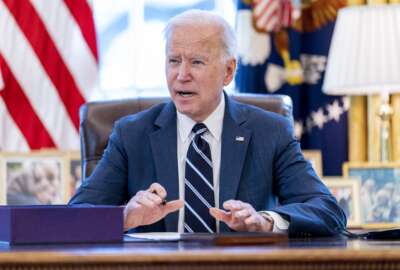House legislators push 5.1% pay raise for all feds
As part of the FAIR Act, 62 lawmakers urge leaders in the House Committee on Appropriations leaders to incorporate a 5.1% pay raise for federal employees in the...
House lawmakers are trying to address two big problems agencies face. The latest push for a 5.1% pay raise in fiscal 2023 attempts to compensate for rising inflation, while lowering the pay gap federal workers face. The goal is to make it a little bit easier to hire the next generation of employees.
Rep. Gerry Connolly (D-Va.), who is leading the charge for the highest pay raise in 25 years, said the increase isn’t enough, but it’s what’s possible. The pay bump will begin to solve some long-standing challenges for the federal workforce, Connolly told Federal News Network.
The increase aligns with the House’s Federal Adjustment of Income Rates, or FAIR Act, which aims to strengthen the federal workforce by implementing a higher across-the-board pay raise for federal employees.
In a letter to the House Committee on Appropriations, 62 representatives urged Chairwoman Rosa DeLauro (D-Conn.), as well as Ranking Members Kay Granger (R-Texas), Mike Quigley (D-Ill.) and Steve Womack (R-Ark.), to implement the increase in the fiscal 2023 Financial Services and General Government appropriations bill.
The request is half a percent higher than that in the White House’s fiscal 2023 budget request. The Biden administration asked for a 4.6% raise for the federal workforce.
Connolly, the FAIR Act’s sponsor, said that the Biden administration’s proposal of a 4.6% raise for the federal workforce is much closer to House legislation requests than it has been in recent years.
“In the last 12 years, we’ve seen some healthy increases, but we’ve also seen pay frozen. We’ve seen zero increases or 1%. So our goal is to try to meet the pay gap in federal wages,” Connolly said in an interview with Federal News Network.
The 5.1% pay raise has garnered significant support from House legislators.
“The federal government has a history of chronic underinvestment in its most valuable asset: the federal workforce,” the letter stated.
The legislators point to a 2020 report from the Federal Salary Council that says federal employees make on average 23.1% less than their counterparts in the private sector.
“Over the past decade, federal employee pay increases failed to keep pace with rising labor and living costs. Additionally, federal workers weathered multiple pay freezes, hiring freezes and lost pay as the result of sequestration-related furloughs including two of the longest government shutdowns in U.S. history,” the letter stated.
But there are some issues with an across-the-board raise for the federal workforce. Some argue that record-high inflation levels, now at 8.5%, as well as market volatility, could make 5.1% look like a loss for federal workers. Connolly argued that the 5.1 number was higher, yet still realistic.
“If you can get to 8.5%, that’s great, but we have never gotten the 5.1%,” Connolly said. “So we picked the number that was a high number, but one we thought we could achieve.”
The 5.1% proposed pay raise has garnered support from federal unions, such as the American Federation of Government Employees. AFGE stated that Congress and the White House continually fail to adhere to local labor market comparability for federal pay systems.
“As a result, federal employees are underpaid relative to their non-federal counterparts,” AFGE stated.
Implementing a virtually across-the-board pay raise for federal employees causes issues with recruiting high-quality employees to necessary sectors in the federal government, such as cybersecurity and acquisition professionals, said Ron Sanders, chairman of the Federal Salary Council from 2017 to 2020 and the current staff director for the Florida Center for Cybersecurity at the University of South Florida.
“Because that pay raise is untargeted, it may be too much for some, and not nearly enough for other occupational categories,” Sanders said in an interview with Federal News Network. “The federal government overpays for some job categories, and underpays for some job categories. The underpaid categories are the most worrisome, because they involve things like cybersecurity and engineers and scientists and procurement — exactly the kind of people who you would want to pay according to market rates.”
Sanders added that federal wages are tied to cost of labor, rather than cost of living, through the Labor Department’s Employment Cost Index (ECI). The across-the-board raise, which became standard through the Federal Employees Pay Comparability Act of 1990, affects talent acquisition for much needed job sectors in the federal workforce.
“If it weren’t for special pay rates and agencies in many cases having their own salary systems for cybersecurity professionals, the federal government would just not be competitive for that kind of talent,” Sanders said.
As more federal workers become eligible to retire, though, the pay raise becomes even more significant as a way to boost recruitment and retention of early-career workers.
“A third of the federal workforce is eligible for retirement sometime in the next five years,” Connolly said. “How are we going to attract the workforce of the future if we continue to fall further and further behind in the wage gap?”
The latest numbers show that 15% of federal workers can retire today, and 30% will be eligible for retirement in the next five years.
Creating a strong pipeline to hire younger workers is also significant as current federal employees are showing lower rates of satisfaction with their jobs and pay rates. Notably, the results of survey data from OPM’s 2021 Federal Employee Viewpoint Survey showed a 6% drop in pay satisfaction since 2020.
Declines in employee engagement and satisfaction in the 2021 FEVS are partly a result of more agencies making return-to-office plans over the last year. But, lessons learned about workplace flexibilities from the pandemic will also support the recruitment of the next generation of federal workers, Connolly said.
“We’re going to have to incorporate more flexible schedules, we’re going to have to move away from a rigid rules-based work setting,” Connolly said. “The pandemic has shown us the way to do that, and do it relatively successfully. What we have learned is we know how to do it, we know how to make it work and we know how to entice productivity in that kind of environment.”
To address the wage gap between the public and private sectors, Connolly said internships are another key component that he’s looking at, particularly in the Building the Next Generation of Federal Employees Act, also known as the NextGenFeds Act, which would establish an internship and fellowship center under the Office of Personnel Management.
The Biden administration is also looking to strengthen internship opportunities at agencies. The fiscal 2023 budget request asked for 30,000 internships to be made available next year, with a larger percentage of those being paid internships.
Actually retaining those interns, and recruiting them to full-time positions, is the next piece of the solution, Connolly said. It’s something that agencies struggle with, and a heightening problem due to more federal workers nearing retirement age.
“In the private sector, you’re looking at somewhere north of 75% of the people who get an internship being offered a job in that company,” Connolly said. “In the federal government, we’re looking at single digits. That means over 90% of people who do get an internship with the federal government never worked for the federal government again. And that’s a wasted effort.”
Connolly said he supports the White House’s boost for federal internships and added that the NextGenFeds Act would give those programs a vehicle through which to create better pathways to full-time civil service.
“We have to match that with a structured program. We’ve got to create architecture for ensuring that those internships are positive experiences, so that these young people will have a good experience and want to consider public service with the federal government as a career path,” Connolly said.
Copyright © 2025 Federal News Network. All rights reserved. This website is not intended for users located within the European Economic Area.
Drew Friedman is a workforce, pay and benefits reporter for Federal News Network.
Follow @dfriedmanWFED






